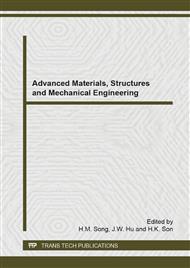p.167
p.173
p.178
p.183
p.192
p.196
p.200
p.208
p.215
Evaluation of Longitudinal Modulus of Elasticity in Wood Species for Structural Application
Abstract:
1024x768 This research aimed to investigate possible differences in values of longitudinal modulus of elasticity for wood species usually employed for structural purposes, as Castanheira (Bertholletia excelsa), Cambará (Erisma uncinatum), Cumaru (Dipteryx odorata), Jatobá (Hymenaea stilbocarpa), Garapa (Apuleia leiocarpa) and Peroba Rosa (Aspidosperma polyneuron), obtained from compression and tension parallel to grain, and static bending tests. Recommendations of the Brazilian standard ABNT NBR 7190:1997, Annex B, were followed. Statistical analysis results for the cited properties, had equivalent averages for the six wood species analyzed. This confirms that any of the three tests can be used to obtain the longitudinal elastic modulus and which could avoid the necessity of evaluating stiffness values for wood by more than one kind of mechanical test. Normal 0 21 false false false PT-BR X-NONE X-NONE /* Style Definitions */ table.MsoNormalTable {mso-style-name:"Tabela normal"; mso-tstyle-rowband-size:0; mso-tstyle-colband-size:0; mso-style-noshow:yes; mso-style-priority:99; mso-style-qformat:yes; mso-style-parent:""; mso-padding-alt:0cm 5.4pt 0cm 5.4pt; mso-para-margin:0cm; mso-para-margin-bottom:.0001pt; mso-pagination:widow-orphan; font-size:11.0pt; font-family:"Calibri","sans-serif"; mso-ascii-font-family:Calibri; mso-ascii-theme-font:minor-latin; mso-fareast-font-family:"Times New Roman"; mso-fareast-theme-font:minor-fareast; mso-hansi-font-family:Calibri; mso-hansi-theme-font:minor-latin; mso-bidi-font-family:"Times New Roman"; mso-bidi-theme-font:minor-bidi;}
Info:
Periodical:
Pages:
192-195
Citation:
Online since:
September 2014
Price:
Сopyright:
© 2014 Trans Tech Publications Ltd. All Rights Reserved
Share:
Citation:


